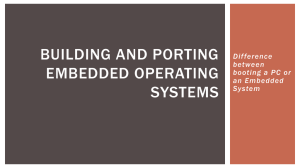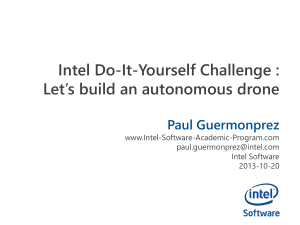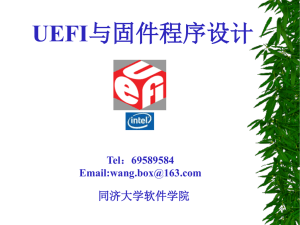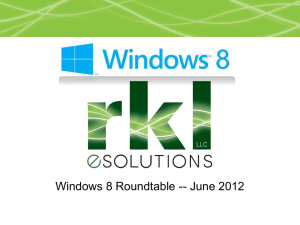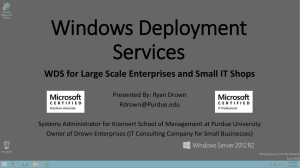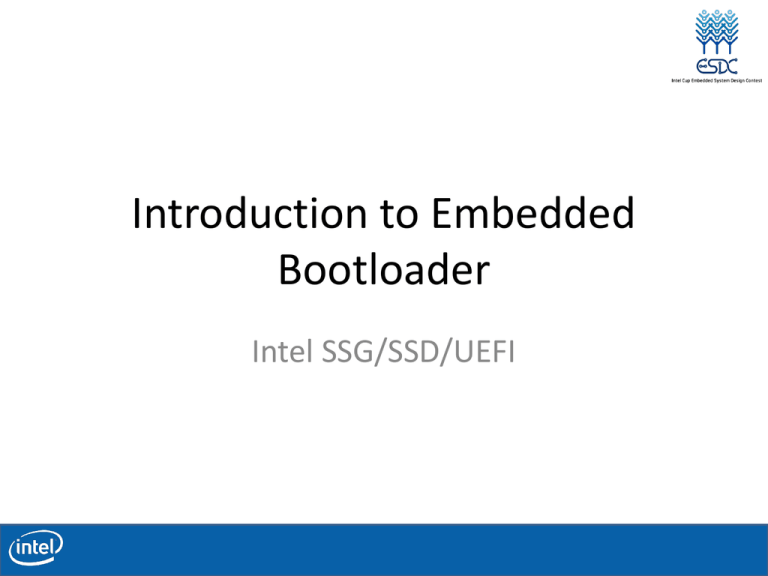
Introduction to Embedded
Bootloader
Intel SSG/SSD/UEFI
Legal Disclaimer
INFORMATION IN THIS DOCUMENT IS PROVIDED IN CONNECTION WITH INTEL PRODUCTS. NO LICENSE, EXPRESS OR IMPLIED, BY ESTOPPEL OR OTHERWISE, TO
ANY INTELLECTUAL PROPERTY RIGHTS IS GRANTED BY THIS DOCUMENT. EXCEPT AS PROVIDED IN INTEL'S TERMS AND CONDITIONS OF SALE FOR SUCH
PRODUCTS, INTEL ASSUMES NO LIABILITY WHATSOEVER AND INTEL DISCLAIMS ANY EXPRESS OR IMPLIED WARRANTY, RELATING TO SALE AND/OR USE OF
INTEL PRODUCTS INCLUDING LIABILITY OR WARRANTIES RELATING TO FITNESS FOR A PARTICULAR PURPOSE, MERCHANTABILITY, OR INFRINGEMENT OF ANY
PATENT, COPYRIGHT OR OTHER INTELLECTUAL PROPERTY RIGHT. UNLESS OTHERWISE AGREED IN WRITING BY INTEL, THE INTEL PRODUCTS ARE NOT DESIGNED
NOR INTENDED FOR ANY APPLICATION IN WHICH THE FAILURE OF THE INTEL PRODUCT COULD CREATE A SITUATION WHERE PERSONAL INJURY OR DEATH
MAY OCCUR.
Intel may make changes to specifications and product descriptions at any time, without notice. Designers must not rely on the absence or characteristics of any
features or instructions marked "reserved" or "undefined." Intel reserves these for future definition and shall have no responsibility whatsoever for conflicts or
incompatibilities arising from future changes to them. The information here is subject to change without notice. Do not finalize a design with this information.
The products described in this document may contain design defects or errors known as errata which may cause the product to deviate from published
specifications. Current characterized errata are available on request.
Contact your local Intel sales office or your distributor to obtain the latest specifications and before placing your product order.
Copies of documents which have an order number and are referenced in this document, or other Intel literature, may be obtained by calling 1-800-548-4725,
or go to: http://www.intel.com/design/literature.htm
This document contains information on products in the design phase of development.
All products, computer systems, dates, and figures specified are preliminary based on current expectations, and are subject to change without notice.
Intel, Intel Atom, Intel Core, and the Intel logo are trademarks or registered trademarks of Intel Corporation or its subsidiaries in the United States and other
countries.
* Other names and brands may be claimed as the property of others.
Copyright © 2011, Intel Corporation. All rights reserved.
Agenda
• Define embedded system
• Standard Boot Loader
• Embedded Boot Loader
– Stages of embedded boot loader
– Available embedded boot loader
•
•
•
•
Non IA boot loaders
Embedded, IA and Compute Continuum
Reasons and Rational
IA Boot Loader
Components of a typical Embedded
System
Embedded is a “specialized” computing system.
System BIOS Boot Sequence
Source: Gustavo Duarte
Reset Vector
•
BIOS is a layer between OS and hardware
– Every platform needs a specific BIOS. But an OS can load on any platform.
– BIOS provides low level hardware details through the OS by means of ACPI and MP tables
besides “Run time ISR’s”.
•
BIOS knows platform in details
–
–
–
–
Interrupt routing
μCode update
Chipset workarounds
Memory usage…
System BIOS initializes low-level
platform details.
How Commercial BIOS Works?
Power-ON/ Reset start
at 0xFFFFFFF0
Initialize RAM, PCI,
Video …
(real mode – 16 bits)
Execute POST
Configure Interrupt
Services
Rese
t
Execute
SETUP
Ye
s
F1 /
DEL?
N
o
MBR
Important
memory regions
during boot
BIOS layout the memory regions for OS to operate properly.
Possible BIOS Issues
• Redundant – Modern Operating Systems initialize
hardware by itself and don’t use BIOS Interrupt
services.
• Performance – Commonly runs on real mode.
• Suboptimal – Some commercial BIOS configure
devices in a suboptimal way.
• Cost – Expensive for embedded platforms.
BIOS
has inherent
constraints
for embedded systems!
• BUGs
– Can not
fix it yourself!
Embedded Bootloaders
• Foundational component for embedded software.
• Possible requirements of embedded bootloader:
– Small Footprint
– Easy Portability
– Fast Boot, or
– Capability to support certain specific features.
• Development of a bootloader
– Write from scratch
– Tailor an existing open source bootloader to suit the need.
– Embedded
Use 3rd partyBootloaders
to develop have diversified
requirements.
Embedded Bootloader Architecture
• In general, bootloader architecture depends on:
–
–
–
–
Processor family,
Chipsets present on the hardware platform,
Boot device, and
OS running on the device.
• Effects of the processor family on bootloader architecture:
– Even when two platforms are based on similar processor cores, the
bootloader architecture may differ based on the SoC.
– An x86 bootloader might need to switch to protected mode to load
a kernel bigger than the 1MB real-mode limit.
– Non x86 embedded platforms cannot avail legacy BIOS services.
– A bootloader for a device designed around the StrongARM
processor has to know whether it's booting the system or waking it
up from sleep, because the processor starts execution from the top
of its address space.
Embedded Bootloaders require fixed functional characteristic.
Embedded Bootloaded Features
• At the minimum, a bootloader is responsible for
–
–
–
–
Processor- and board-specific initializations,
Loading a kernel,
Initial ramdisk into memory, and
Passing control to the kernel.
• In addition
– Might provide BIOS services (POST, firmware download, passing
memory layout and configuration information to the kernel).
– Decryption for encrypted firmware images.
– Debug monitor to load and debug stand-alone code on to the
target.
– Failure-recovery mechanism to recoup from kernel corruption.
– Require device-specific modifications.
– Update capacity through interfaces such as UART, USB or Ethernet.
Embedded Bootloaders need to be extensible.
Deployment Comparison of Boot
Bootloader Flow
Flows PC BIOS Flow
Bootloader
FLASH
BIOS
Kernel
FLASH
(compressed)
Rootdisk
Bootstrap
(compressed)
Kernel
Kernel
RAM
Rootdisk
User
Memory
RAM
User
Memory
Embedded Bootloaders require specialized boot steps.
Rootdisk
Bootstrapping for Embedded Bootloader
• Bootstrapping is the mechanism to transfer a bootloader image from the host
development system to the target's boot device.
– Bootstrapping is straightforward on PC-compatible systems.
– Embedded devices do not have a generic method for bootstrapping.
• The boot suite has to be architected into two steps, each loaded at a different
address:
– The first step (the 128-byte image) is part of processor firmware.
Note: Processor-resident microcode (the first step) cannot function as the bootstrapper
because a bootstrapper needs to have the capability to program flash memory. Many
types of flash chips can be used with a processor, the bootstrapper code needs to be
board-specific.
– The second step lives in the on-chip SRAM, so it can be up to 2KB. This is the bootstrapper.
• The bootstrapper downloads the actual bootloader image from an external host to the
top of flash memory. The bootloader gets control when the processor powers on in
normal operation mode.
• Many embedded controller chips do not support a bootstrap mode. Instead,
the bootloader is written to flash via a JTAG interface.
Primarily Embedded Bootloaders do not follow exact steps of
System BIOS.
Developing Embedded Bootloader
• Understand the hardware environment
– Memory mapping,
– I/O mapping, and
– Interrupt Vectors.
• Understanding program loader:
– the transition of control from ROM to RAM,
– initializing the RAM, and
– loading "C" code in RAM then transferring the control to "C" code.
• Necessary programming and debugging tools.
• Make sure programming and debugging tools are
compatible with the hardware environment.
• Board design meets the “proper” spec.
– Perform some simple tests to verify that the hardware
is working.
Proper board design is very important for functional
embedded bootloader.
How Typical Embedded Bootloader
Works?
Power-ON/ Reset start
at 0xFFFFFFF0
Switch to Protected
Mode – 32-bits
Execute payload
Initialize chipsets, SIO
(Linux, LILO, etherboot)
Configure serial for debug
Initialize DRAM
Basic Bootloader Architecture/Flow
Linux Boot in a nutshell
Power-ON/ Reset
System startup
Bootloader
First Stage bootloader or
Initial Boot Loader (IPL)
Master Boot Record
Second Stage bootloader or
Secondary Program Loader
(SPL)
LILO, GRUB, etc
Kernel
Init
Linux
User space
Functional
Application
Operation
Multi-stage bootloader brings flexibility!
Source: Trego Ltd.
WinCE and Bootloader
Source: Microsoft
From performance scenario (projected):
(loadcepc boot time ≈ 30-40 sec]) > (BIOS_load_image boot time ≈ 20-30 sec) >> (IPL < 10 sec)
Today’s WinCE has specific bootloader steps.
Available Bootloaders
(relative list, not a comprehensive one)
Bootload Video
Support
er
Architectures
Description
x86
ARM PowerPC MIPS SuperH m68k
LILO
No
The main disk bootloader for Linux*
X
GRUB
No
GNU's successor to LILO
X
Loadlin
No
Loads Linux from DOS
X
No
Loader to boot systems through Ethernet cards
X
No
Linux-based BIOS (LinuxBIOS) replacement
X
blob
No
Loader from the LART hardware project
PMON
Yes
Loader used in Agenda VR3
sh-boot
No
Main loader of the LinuxSH project
U-Boot
Yes
Universal loader based on PPCBoot and ARMBoot
X
X
X
RedBoot
Yes
eCos-based loader
X
X
X
Etherboot
CoreBoot
X
X
X
Need a flexible and extensible x86 bootloader.
X
X
X
Available Bootloaders for Linux
• Bootloaders for Multiple Architectures
– U-Boot (http://sourceforge.net/projects/u-boot/) or
(http://www.denx.de/wiki/U-Boot/WebHome)
• Universal Boot Loader supports PPC, ARM, and others
– RedBoot
(http://www.redhat.com/services/custom/embedded/redboot/
)
•
•
•
•
RedHat Embedded Debug and Bootstrap
Based on the eCos HAL, RedHat.
Capable of flash and network booting of Linux* kernel.
Supports ARM, MIPS, PowerPC, and x86
– Smart Firmware (http://www.codegen.com/SmartFirmware/)
• Written entirely in ANSI C. Designed to be very easy and fast to port.
• Supports PowerPC, ARM, x86, MIPS, Sparc, M68k
Available Bootloaders for Linux
• Bootloaders for x86 Architectures
– LILO (Linux* LOader) (http://lilo.alioth.debian.org/)
– GRUB (GRand Unified Bootloader)
(http://www.gnu.org/software/grub) (planned for ARM)
(http://arm-grub.sourceforge.net/)
– Etherboot (http://etherboot.org/wiki/)
• Open source network bootloader and substitute of proprietary PXE.
– CoreBoot (http://www.coreboot.org/)
• Based on LinuxBIOS (http://www.acl.lanl.gov/linuxbios/index.html)
• Replacing the normal BIOS with fast boot from a cold start.
Available Bootloaders for Linux
• Bootloaders for ARM* Architectures
– Blob (http://sourceforge.net/projects/blob/)
• Boot Loader Object for StrongARM based platforms.
• Bootloaders for PPC* Architectures
– Yaboot (http://yaboot.ozlabs.org/)
• It works on “New” class PowerMacs (iMac and later) only.
Embedded, IA and Compute
Continuum
Embedded
Solutions
SoC derivatives
from different
form factors
Architectural
Migration
BIOS
IA
Customized Boot
Loaders (3rd Party
or Open Source)
Other
Architectures
Boot Loaders
Primarily Fixed
Functionality
Generic
Functionality
Compute Continuum
“IA Boot Loader” is a natural progression for
Embedded Solutions.
IA Bootloader Distribution and Scalability
OS Handoff
Unprotecte
d
Boot Device
Device Enumeration
Chipset Init
Intel Restricted
Secret
Arch.
Memory Init (MRC)
Cache Init
uCode Patch
Initial HW State
Issues related to IA based bootloader development:
–
–
–
–
IA is complex with superior feature set
IA has inherent IP concerns
IA initialization is relatively complex
RS-NDA is required for customer to have access source to
modify reference FW for Customer boards
Intel is addressing the embedded bootloader need.
Reasons and Rational
BIOS has inherent constraints for embedded systems
No common framework for embedded framework to
take advantages.. Such as Linux, WinCE, and other
embedded OSes.
• Embedded Bootloaders have diversified requirements.
• Embedded Bootloaders require fixed functional character
• Embedded Bootloaders need to be extensible.
Need a flexible and extensible x86 bootloader.
“IA Boot Loader” is a natural progression for Embedded So
Focus is to connect the flexible BIOS and embedded
bootloader, and target the generic IA architecture to meet
the end-to-end solution for embedded!
Intel & Embedded Bootloader
Display
Memory
Reset
Bus
ROM Update
Legacy
Compatibility
Network
OS Services
Storage
Simple I/O
Peripheral
Drivers
Security
Power
Management
System
Management
Dynamic Setup
Virtualization
BIOS
Intel® BLDK
Intel® BLDK Provides Flexibility to Scale System
Initialization for Embedded Systems

